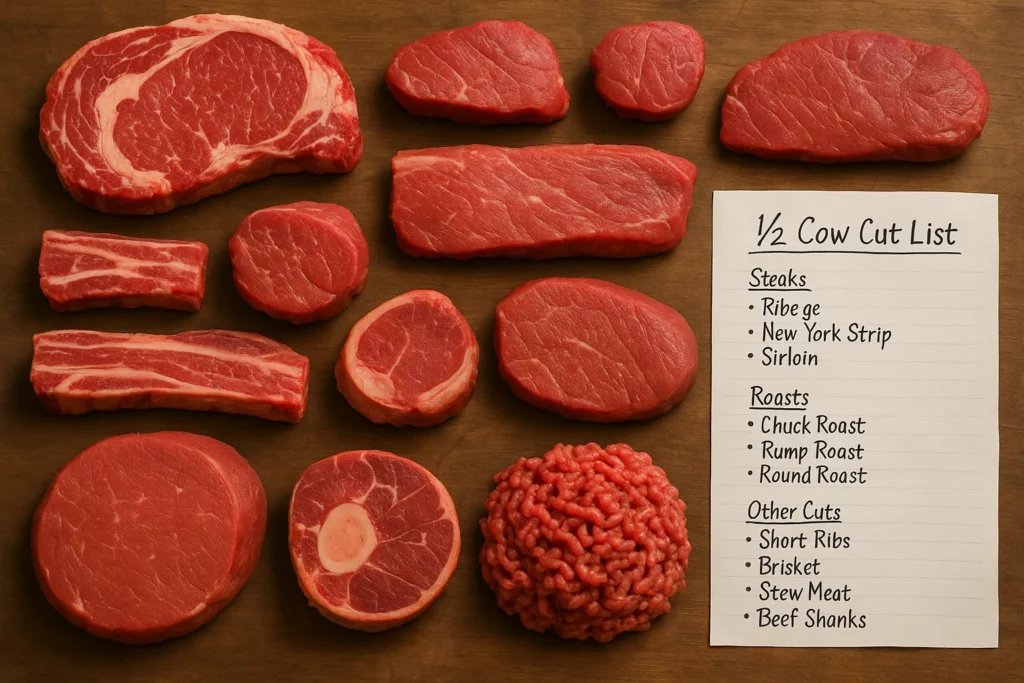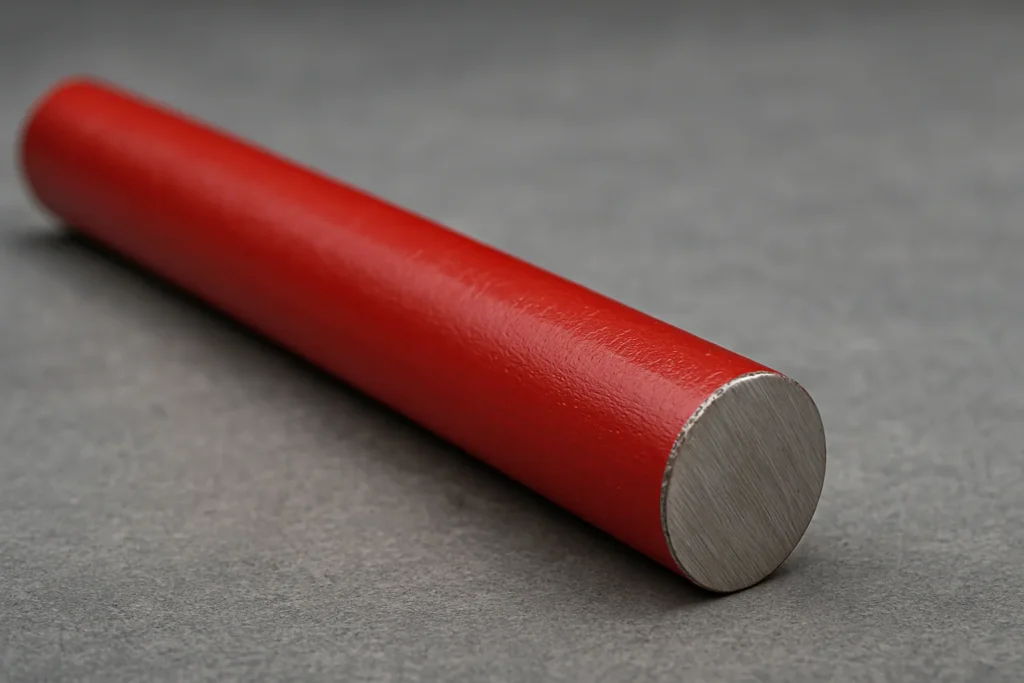So, you’ve decided to buy half a cow. That’s awesome! Not only is it a smart way to save money on high-quality beef, but it also gives you complete control over what ends up in your freezer. The only tricky part? Figuring out what exactly you’re getting — and how to fill out that mysterious “cut list” your butcher hands you.
Here’s the thing: a 1/2 cow cut list isn’t one-size-fits-all. It’s a customizable breakdown of steaks, roasts, ground beef, and other cuts that you choose based on how you like to cook. Whether you’re grilling ribeyes, slow-cooking chuck roasts, or making weekly taco meat, your cut choices decide how your beef is divided up. And trust me, once you’ve done it once, you’ll never go back to buying random grocery store packages again.
In this guide, I’ll walk you through what comes in half a cow, how to fill out your butcher sheet, what it costs, and some personal tips I’ve learned after years of splitting cows with neighbors and friends.
Snippet-Ready Definition:
A 1/2 cow cut list is a breakdown of all the beef cuts you receive when buying half a cow — including steaks, roasts, ground beef, and custom butcher options.
Understanding “Half a Cow” in Practice
Buying half a cow doesn’t mean you literally get half the animal cut down the middle — it’s actually a full side of beef, divided into front and back quarters. Each half includes steaks, roasts, ribs, and a good amount of ground beef.
Now, let’s talk numbers. A typical half cow has a hanging weight of about 300 to 400 pounds. After trimming and processing, you’ll take home around 200 to 220 pounds of actual beef. That’s a lot of meals, usually filling about 7 to 10 cubic feet of freezer space. If you’ve got a chest freezer, that’s perfect.
Something else most people don’t realize: not all cows are the same. Breed, feed, and finishing style all affect what your meat looks and tastes like. For example, grass-fed cows tend to be leaner with a richer flavor, while grain-finished ones often have more marbling and tenderness.
The best part is, you get to decide how your beef is prepared. Want more steaks? Go for it. Prefer more ground beef for burgers? Your butcher can grind more of the roasts. That’s the beauty of customization.
Common Cuts You’ll Get in a 1/2 Cow
When you first see your cut sheet, it might look like a foreign language — but don’t worry, it’s not as complicated as it seems. Let’s break it down by sections.
Steaks
Everyone loves steaks, and you’ll get a nice variety from your half cow. Some of the most popular include:
- Ribeye: Juicy, tender, and perfect for the grill. You’ll usually get about 6–8 from half a cow.
- New York Strip: Another favorite, often boneless and cut thick.
- Filet Mignon or Tenderloin: Lean, buttery soft, but only a few per side — so treat them like gold.
- Sirloin: Great for everyday meals, with that rich beefy flavor.
- T-Bone or Porterhouse: These are part strip, part tenderloin. You’ll get a handful depending on how you divide the loin section.
- Flank, Skirt, or Flat Iron: Perfect for fajitas or stir fry, though you’ll only get one or two of each.
From my experience, if you love grilling, tell your butcher to cut the steaks thicker — around 1 to 1.25 inches — and package them two per pack. You’ll thank yourself later.
Roasts
Roasts are the heart of a good beef order. They’re the comfort food cuts that shine in slow cookers and Sunday dinners. Typical roasts include:
- Chuck roast or shoulder roast – packed with flavor and great for pot roast.
- Rump roast or round roast – leaner and perfect for slicing thin.
- Sirloin tip roast – nice marbling and easy to carve.
- Brisket – if you’re a smoker fan, this is your treasure.
- Eye of round – lean, easy to slice for sandwiches.
Here’s a tip: if you don’t cook large roasts often, ask for smaller 2 to 3-pound portions. That way, you can thaw what you need without wasting meat.
Ground Beef and Trimmings
Now, let’s be honest — most families use more ground beef than anything else. Depending on how you order, this can make up 40–50% of your half cow. Expect around 70 to 100 pounds of ground beef.
You can choose the fat ratio too. Many people go with 80/20 for juicy burgers, while others prefer leaner 90/10 for chili or tacos. Your butcher can mix trimmings and fat from different parts of the cow to match your preference.
I usually ask for one-pound packs, vacuum sealed. They stack easily in the freezer and make meal planning simple. You’ll love how much flavor your homemade ground beef has compared to store-bought.
Other Cuts and Extras
Don’t overlook the extras — they’re where you get the most value.
- Short ribs for braising.
- Soup bones for broth or stock.
- Beef shanks (also called Osso Buco) for slow cooking.
- Stew or kabob meat cut into cubes.
- Organ meats like liver, heart, and tongue — not for everyone, but incredibly nutritious.
- Fat or suet if you like rendering your own tallow.
If you’re into nose-to-tail cooking, tell your butcher to save everything. Even the bones can be turned into rich, golden broth that’s perfect for winter soups.
Example Cut Lists from Ranches and Butchers
Every ranch or meat processor has its own way of dividing a half cow, but the basics stay similar. For example, Augustus Ranch lists about 100 pounds of ground beef, 30 pounds of steaks, 25 pounds of roasts, and around 10 pounds of miscellaneous cuts like brisket, short ribs, and stew meat in their half beef package.
At Lazy R Ranch, the typical half includes ribeyes, sirloins, tenderloin, chuck roasts, brisket, and about 80 pounds of ground beef. Meanwhile, smaller farms might adjust depending on breed or customer preference — some even include bones and organs by default.
Here’s the thing: every cut list is slightly different because you decide what matters most to your family. Want more steaks? That means fewer roasts. Prefer soups and braises? You can turn more of the loin into roasts and ground.
I always recommend asking your rancher or butcher for a sample half beef cut sheet before you order. It gives you a visual guide to all your choices and makes it easier to communicate your preferences.
How to Fill Out the Half Beef Cut Sheet
So, your rancher sends you a “cut sheet” or “beef order form,” and suddenly it feels like homework. Don’t worry — it’s easier than it looks once you understand what’s what. The form basically tells your butcher how you want your beef processed, packaged, and portioned.
Here’s what you’ll usually decide:
- Steak thickness: Most folks choose between ¾ and 1¼ inches. If you love grilling, thicker is better.
- Packaging size: Two steaks per pack works best for most families.
- Roast weight: Smaller families go for 2–3 lb roasts; larger ones might choose 4–5 lb portions.
- Ground beef packaging: One-pound packages are ideal for easy meal planning.
- Bone-in or boneless: Bone-in steaks have more flavor but take more freezer space.
- Fat and trimmings: Decide if you want your fat (tallow), bones, or organs saved.
The key is communication. Don’t be shy about asking your butcher questions. Tell them how you cook — if you make lots of crockpot meals or grill on weekends, that changes how they’ll cut things.
One thing I learned early on: butchers appreciate details. If you’re unsure, ask for their recommendations. They process hundreds of sides every year and can easily guide you toward the right choices for your lifestyle.
How Many Cuts Can You Really Expect?
Let’s get specific, because this is where most people are curious. A half cow usually gives you about 200 to 220 pounds of meat after processing, depending on the breed and trimming preferences.
Here’s a ballpark breakdown from my own experience and a few local processors:
- Ribeye steaks: 6–8
- T-bones or Porterhouse: 5–7
- Sirloin steaks: 8–10
- Tenderloin / Filet Mignon: 3–4 small cuts
- Chuck roasts: 4–6
- Rump or Round roasts: 2–3
- Brisket: half of a full brisket, usually 6–8 lbs
- Ground beef: 70–100 lbs
- Short ribs / stew meat / shanks: around 10–15 lbs
If you’re wondering how many ribeyes in half a cow, it depends on how thick you like them. Cut thinner, you’ll get more — but I always suggest thicker cuts for quality.
And for the most common question — how many steaks in half a cow? — expect around 40 to 50 total, depending on the animal and your chosen thickness.
Here’s the best part: you can customize it. Want more ground beef for tacos and burgers? Ask to grind extra roasts. Prefer more steaks? Keep more loin cuts whole. You’re in control.
Price, Cost, and Value Breakdown
Now let’s talk money, because understanding pricing helps you appreciate the real value of buying half a cow.
Most ranchers charge based on hanging weight, not the final take-home pounds. That means you’ll pay a price per pound (for example, $5.00/lb) on the hanging carcass before trimming and deboning. Processing or butcher fees are often extra — usually around $1.00 to $1.25 per pound.
So, if your half cow has a hanging weight of 350 lbs, you might pay around:
- $1,750 for the beef itself
- $350–$400 in processing fees
- Total: about $2,100–$2,200
You’ll end up with roughly 200 lbs of packaged beef, meaning your real cost per pound averages around $10–$11/lb — but remember, that includes premium steaks, roasts, and ground beef all together.
Compare that to buying at the grocery store, where ribeyes alone can cost $15–$20/lb, and it’s clear why buying a half cow makes sense. You’re getting top-quality, locally raised meat for a fraction of retail prices.
Another bonus: you know exactly where your food comes from and how it was raised. That’s real value you can taste.
Cooking and Usage Strategy: Making the Most of Your Cuts
Once your freezer is full, the fun part begins — figuring out how to enjoy it all. The trick is balance. You don’t want to eat only ground beef for months and then realize you still have 15 roasts left.
Here’s how I manage my half cow:
- Plan by cut: I make a list of all my steaks, roasts, and ground packages.
- Rotate meals: One week I’ll grill steaks, the next I’ll slow-cook a roast, then switch to burgers.
- Use every bit: Bones make incredible bone broth. Suet can be rendered into tallow for cooking or soap-making.
Need a few easy meal ideas?
- Chuck roast: slow-cooked with onions and potatoes for classic pot roast.
- Short ribs: braised in red wine until tender.
- Flank steak: marinated and grilled for fajitas.
- Brisket: smoked low and slow for weekend gatherings.
The best part is how much more flavorful and tender your beef will be compared to store-bought meat. You’ll taste the difference — guaranteed.
Expert Tips and Butcher Advice
Over the years, I’ve picked up some solid advice from butchers who know their craft inside out.
- Ask for vacuum sealing. It costs a little more, but it keeps your meat fresh for up to two years in the freezer without freezer burn.
- Don’t forget about soup bones. They’re packed with collagen and flavor — perfect for homemade broth.
- Keep a freezer log. Write down what’s in there and cross it off as you use it. It saves time and avoids waste.
- Choose steak thickness carefully. I’ve had thin-cut steaks dry out too easily on the grill. Stick with thicker cuts for better results.
- Communicate with your butcher. Tell them what kind of meals you like to cook. They can recommend cuts that fit your habits perfectly.
And one more thing — don’t be afraid to try something new. Some of the lesser-known cuts, like flat iron or tri-tip, have incredible flavor when cooked right.
Quarter Cow vs Half Cow: Which Is Right for You?
People often ask if they should buy a quarter cow instead. Here’s the quick comparison:
- A quarter cow gives you about 100 lbs of meat, perfect for smaller families or limited freezer space.
- A half cow offers better pricing, more variety, and more control over your cuts.
If you’re new to this, starting with a quarter can be a great test run. But once you experience the convenience and savings, most folks upgrade to a half the next time around.
Storage, Labeling, and Long-Term Tips
Make sure your freezer is organized — it’ll save you a ton of headaches later. Keep similar cuts together, like steaks in one bin and ground beef in another. Label each package with the cut name and date.
Pro tip: store newer packages at the bottom and use older ones first. This rotation keeps your meat fresh and prevents waste.
If you’re wondering how long beef lasts in the freezer, vacuum-sealed packages can last 18–24 months easily, while paper-wrapped ones are best used within a year.
Comparison Table: Quarter Cow vs Half Cow
| Feature | Quarter Cow | Half Cow |
| Average Take-Home Meat | 100–120 lbs | 200–220 lbs |
| Freezer Space Needed | 4–5 cu. ft. | 8–10 cu. ft. |
| Common Steaks | Ribeye, Sirloin | Ribeye, Strip, Tenderloin, T-Bone |
| Ground Beef | 35–45 lbs | 70–100 lbs |
| Average Cost Range | $1,000–$1,200 | $2,000–$2,300 |
| Customization | Limited | Full control over cuts and thickness |
| Best For | Small families | Larger households or frequent cooks |
Step-by-Step Guide: How to Fill Out a Half Cow Cut Sheet
- Talk to Your Butcher: Ask for a sample cut sheet before ordering.
- Decide Steak Thickness: 1–1.25 inches is ideal for grilling.
- Choose Roast Sizes: 2–3 lbs each for easy meals.
- Select Packaging: Vacuum-sealed, labeled, 1 lb ground beef packs.
- Add Special Requests: Bones, fat, organs, or stew meat.
- Confirm Everything: Review your order before processing.
Frequently Asked Questions
What does 1/2 beef look like?
It’s about 200 pounds of neatly packaged meat — boxes filled with steaks, roasts, ground beef, and a few extras like ribs or bones.
How many ribeyes are in half a cow?
Usually between 6 and 8, depending on thickness.
How many steaks in half a cow?
Expect around 40 to 50 total, though that varies with your choices.
How much freezer space do I need?
Around 8 to 10 cubic feet is perfect for a half cow.
What’s the average 1/2 cow cut list price?
It typically ranges between $2,000 and $2,300 depending on region and butcher fees.
Conclusion
Buying half a cow might feel like a big step at first, but once you do it, you’ll realize it’s one of the smartest food investments you can make. You’ll fill your freezer with premium beef, know exactly where it came from, and enjoy the satisfaction of using every part — from juicy ribeyes to hearty soups.
Here’s the thing — it’s not just about saving money or stocking up. It’s about reconnecting with your food, supporting local farmers, and enjoying real, flavorful meat the way it’s meant to taste.
So take your time, fill out your cut sheet carefully, and don’t be afraid to ask your butcher questions. Before you know it, you’ll be grilling, roasting, and simmering meals that taste better than anything you could buy at the store.
Once you’ve experienced it, you’ll never look at a grocery store steak the same way again.
Disclaimer
This article is for general educational purposes only. Meat processing details, pricing, and yields may vary depending on the ranch, butcher, and location. Always consult your local processor or rancher for specific guidance on your beef order and storage requirements.

Hi, I’m Bilal, the founder of outofmagazine.com. I love sharing fresh ideas, stories, and helpful insights on all kinds of topics that spark curiosity. My goal with this site is simple—to create a space where readers can find inspiration, useful tips, and engaging reads on lifestyle, trends, and everything in between.



